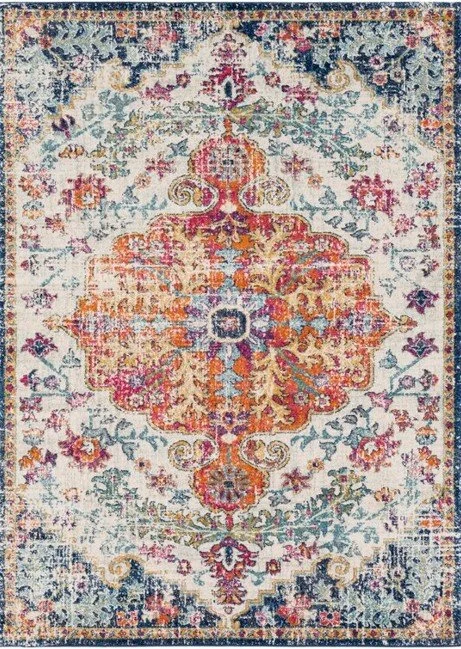The size and shape of many small rooms can make getting the right furniture layout tricky.
You may not know exactly how to arrange your furniture because of multiple doorways, or architectural features like niches, bump-ins, bay windows, or any number of features.
If you’re stressed about your small room, try these 6 tips to make it feel larger, defined, stylized and functional.
Use a Large Area Rug
Wayfair
Big area rugs in small rooms create a larger area for anchoring your furniture.
Michael Helwig Interiors
Sofas go on the long side of the rug chairs on the shorter side.
A large rug will give your furniture arrangement ‘elbow room’ because you’ll be able to position your furniture more appropriately.
That’s why I often say that rugs help you to define your seating space.
Without this outline on the floor, you may feel like you should position furniture too far away or too close together.
Using larger rugs will eliminate that urge to push everything up against opposite walls or crowd your seating too close together.
Tip: At least an 8’ x 10’ rug will fit in most rooms.
Use Large Art
Etsy
If you want impact and a ‘WOW’ factor, display large art in a small room.
Big art covers a lot of space and will always give your small room color and drama.
Big art in small rooms is unexpected and energetic.
It gives you a chance to be playful, provocative, or cohesive.
Etsy
Tip: Use your art as inspiration for accent colors that you can decorate with throughout the room. Repeat the color in pottery, accent pillows, secondary art, and accessories.
A good rule of thumb is to repeat an accent color at least 3 times in a room.
Use Transparent Furniture
CB2
Using furniture that you can see through visually opens up a small room.
Clear furniture still gives you full functionality but being able to see through it makes your room feel lite and open.
Conversely, a closed and clunky piece in a small space will absorb the limited area around making the room feel smaller and confined.
Think of using glass top coffee tables
Acrylic console and/or end tables.
Clear dining room chairs.
Don’t Block Doorways
Rachel Claire
I’ve talked about this one in my peeves video and blog post.
It’s such a hassle to shimmy around things that stick out into doorways, walkways or pathways through a room.
In fact, I ALWAYS include a pathways guide for all my clients in my design services packages.
Michael Helwig Interiors
I pay great attention to how comfortable it should be to walk into and through every room I design.
If you want your small room to feel open and put together, keep your doorways and pathways clear of furniture.
Things that stick out in pathways will make your room feel cluttered and messy.
You’ll grow tired of side-stepping things fast!
Use Vertical Space
Tatiana Syrikova
If you can’t go wide, go high!
Tall items in a small room bring your eye up.
When you capitalize on the height of a room, you shift the focus from the limitations of the floor space to the possibilities of the space between the floor and the ceiling.
Using the height of the room also helps you to vary the height and lines of your décor. By doing that, you make the room interesting and layered.
Where focus goes, energy flows.
Don’t be afraid to use the height of your small room:
Stack art on the wall vertically.
Hang curtain rods high.
Used tall furniture like etageres.
Any way you choose to bring your eye high in a small room will help to make it feel larger.
Use Mirrors
Wayfair
Mirrors can make a room feel larger because they visually double the size of any small room.
Things like leaner mirrors make it seem like there’s a doorway on a solid wall. This tricks you into thinking the room continues and makes the space expand.
A wall covered in mirrors will also double the size of a room. This trick works well in small, narrow rooms.
Aldora Glass
Maybe there’s storage like a closet behind the wall of mirrors. Turn that ‘utilitarian’ space into an opportunity to make the room feel larger.
Take away: Using large mirrors in small rooms to get the most visual expanse.
There you have it; 6 no fail decorating rules for small rooms:
Use the largest rug to define your seating space for the most appropriate furniture arrangement.
Use large wall art for impact and inspiration for accent colors.
Use clear furniture like glass top coffee tables, consoles, and end tables to make the room feel open and yet functional.
Don’t block the doorways and pathways into and through the space with furniture.
Use the vertical wall space in your small room to bring your eye up.
Use large mirrors in small rooms to create visual expansiveness
Now it’s your turn. How do you make your small room feel more open and functional? Tell me about it in the comments below.
Michael Helwig Interiors
Join the Fun!
If you enjoyed this post and you want to keep seeing my weekly blog, the best way to do that is to subscribe.
You can subscribe by downloading my 11 Secrets Only Designers Know to Make Your Space Rock. If you’re curious about how decorators and designers make a home look magazine ready, you’ll love taking a gander at these 11 secrets. You’ll learn how to style your room from the floor up and it will work for ANY space you have.
I write about small space design and decorating, sustainable furniture options, positive self care and a variety of do-it-yourself home décor.
I’d love to connect with you!
“Michael Helwig was top-notch, very professional and responsive to my needs. He allowed me time to explore ideas and try out a variety of combinations until we found the perfect fit. Michael provided detailed information and offered beautiful ideas to make my dream living room become a reality. The furniture he sourced has totally transformed my living room space. Everyone that has seen my new living room has one word, WOW! A special thank you to Michael for a wonderful experience.”
“Michael was very knowledgeable and guided us, with great patience and good humor, through the process of designing our dining room and helping us find the perfect sleeper sofa. He offered really helpful advice when we asked questions - which was often - but at no time did we ever feel pushed. He helped me when I felt like I couldn’t make one more decision. When my new furniture finally arrived I realized everything down to the pillows was perfect. I couldn’t be happier!”
Michael is Principal designer and blogger at Michael Helwig Interiors in beautiful Buffalo, New York. Since 2011, he’s a space planning expert, offering online interior e-design services for folks living in small homes, or for those with awkward and tricky layouts. He’s a frequent expert contributor to many National media publications and news outlets on topics related to decorating, interior design, diy projects, and more. Michael happily shares his experience to help folks avoid expensive mistakes and decorating disappointments. You can follow him on Pinterest, Instagram and Facebook @interiorsmh.


















